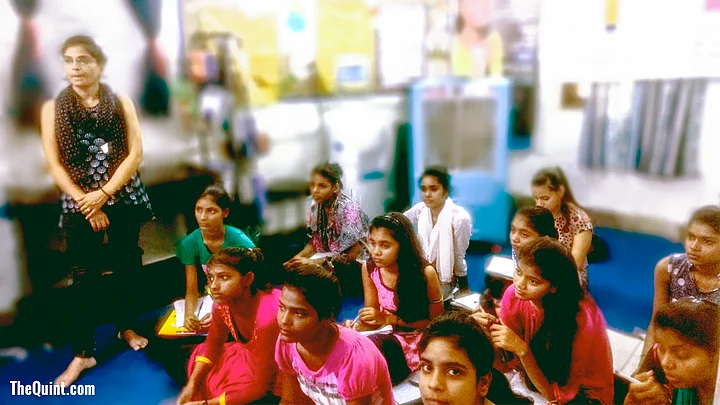“Ek baar thaan leti hoon, toh kar deti hoon.”
15-year-old Aarti’s* eyes sparkle with a mix of determination and enthusiasm. Standing in a narrow corridor in a digital learning classroom in Dwarka, she talks about how she wasn’t interested in studying. “I didn’t study earlier, and used to get around 65 percent. But now looking at classmates around me here, I want to do better,” she says.
Aarti is one of the many girls who study in the 15 digital learning centres in resettlement colonies in Dwarka, Holambi Kalan and Rangpuri Pahadi in Delhi. Set up by Plan India in 2015, these centres provide after-school free tuition to young girls from low-income families.
The twist? It’s a digital classroom, with a teacher sitting in one central hub, and her voice and gestures being simultaneously transmitted to other learning centres.
In School, No Time for Questions
There are nearly 60 children in a class in our school, and we can’t ask questions. Concepts are explained better here and in the centre, I can ask as many questions as I want.
Namita* is a tall girl for a fourteen-year-old, with a seriousness in her gestures which belies her age. Studying in class 9 in a nearby Kendriya Vidyalaya, she comes to the centre every day after her school ends at 12:30 in the afternoon. One subject is taught every day, and like almost all teenagers all over the country, Maths is feared the most.
“I think Maths is the toughest subject, but now I am starting to enjoy it a little bit. Unlike in schools, the teachers are good and explain concepts as many times as I ask them to.”
Namita isn’t alone. The student-teacher ratio in India is extremely skewed.
According to a Ministry of HRD report titled “Educational Statistics At a Glance”, the pupil-to-teacher ratio (PTR) at a secondary level (class 9 to class 10) for 2015-16 is 27 nationally.
But in Delhi, this ratio is distributed across schools unevenly. The Directorate of Education in Delhi has labeled certain schools in Delhi with ‘Urgent Requirement’ — which means that these schools are facing a severe shortage of qualified teachers.
While only 31 percent of government schools in Delhi are labelled “Urgent Requirement”, these schools account for about 45 percent of all students in the city, writes Harry Stevens in the Hindustan Times. With overflowing classrooms and shortage of qualified teachers, girls studying in the digital centres are not the only students looking for tuitions.
What differentiates Plan India’s Digital Learning Centre (DLC) is that it’s free and crucially, located near where the girls live.
Distance As a Barrier to Education
There’s usually a feeling of apprehension of tuition centres, mainly because of distance. Parents worry whether it will be safe for the girls to come and go. So, we had a session inviting parents and explaining to them the system — how it’s safe and how there are only girls here and no boys.
Karuna is a facilitator in the Digital Learning Centre in Dwarka. Speaking in soft and patient tones, she explains how she went to resettlement colonies herself to convince the girls’ parents that the centre is safe.
Most girls’ parents are daily wage labourers, tea sellers, rickshaw-pullers and domestic help. For these families, private tuition is unaffordable. Even in cases where families can afford them, they don’t want to send girls too far away from home.
With the digital learning centre, they can sit in centres close to home and learn from a qualified teacher in a central hub near Dwarka Mor — as she teaches remotely using technical support set up by Plan India in collaboration with Ericsson.
“I can’t take private tuitions. Other places are far away and I can’t travel that far. I heard about this from my friend in school, so I started coming. I have been studying in this centre for a year and my percentage from class 9 to 10 jumped from 65 percent to 80 percent,” says Aarti with a hint of pride in her voice.
Confident and exuberant while talking, she doesn’t mind sitting in the same class twice – once with her own batch and once with others. Unlike Namita who likes listening to songs on the weekends, Aarti isn’t too fond of watching TV.
“But what does she like to do in her free time?”
Aarti pauses before flashing a quick smile and narrating how she teaches her 12-year-old sister on weekends.
But both Namita and Aarti share one thing in common, a trait reflected among other girls in the centre – ambition. While Namita wants to do a Bachelors in history in the University of Delhi, Aarti wants to take up Commerce in class 11.
And in a tiny centre in a narrow lane in Dwarka, it seems nothing can stop these girls.
(*Names changed on request)
(#TalkingStalking: Have you ever been stalked? Share your experience with The Quint and inspire others to shatter the silence surrounding stalking. Send your stories to editor@thequint.com or WhatsApp @ +919999008335.)
